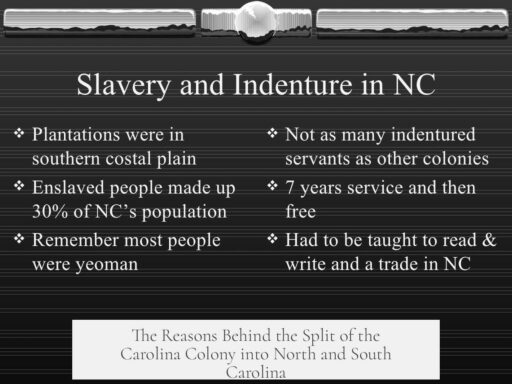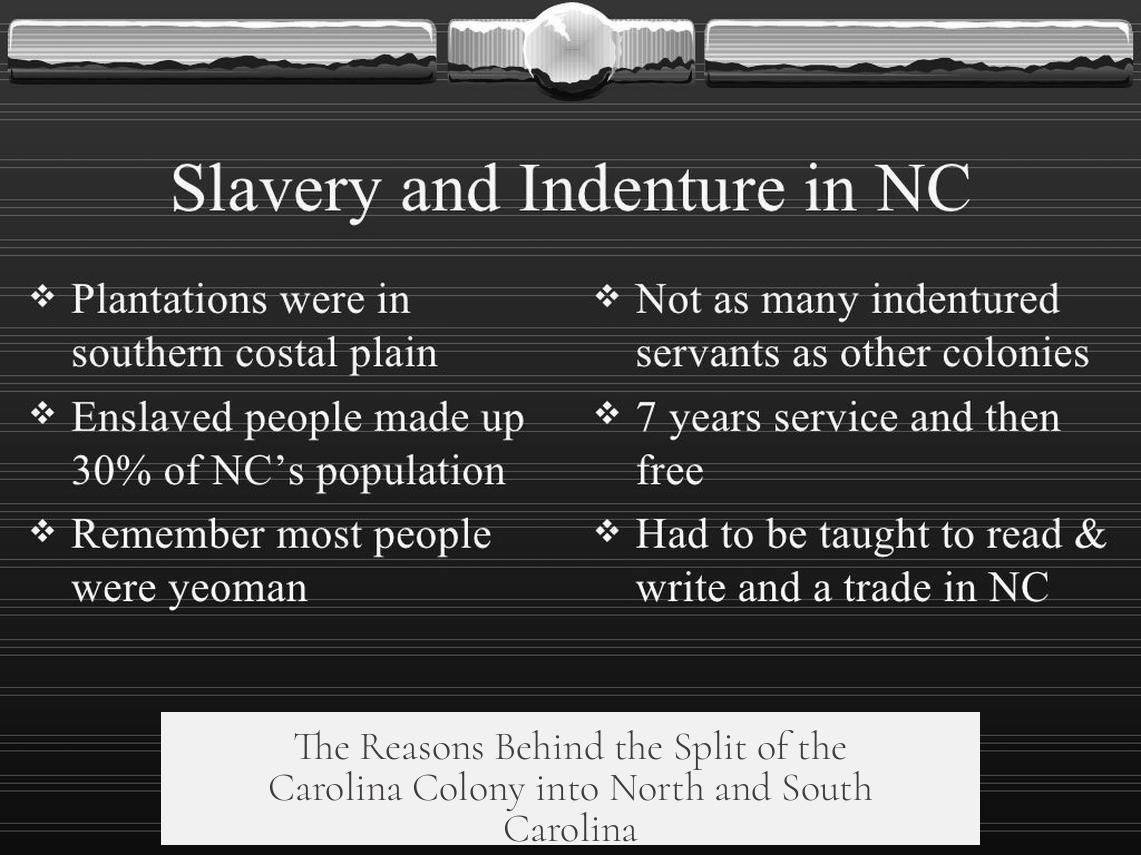The Carolina colony split into North and South Carolina due to significant differences in origins, settlement patterns, geography, economics, and governance challenges. These factors created distinct identities and practical difficulties in uniting the territory under one government, leading to an official division by the early 18th century.
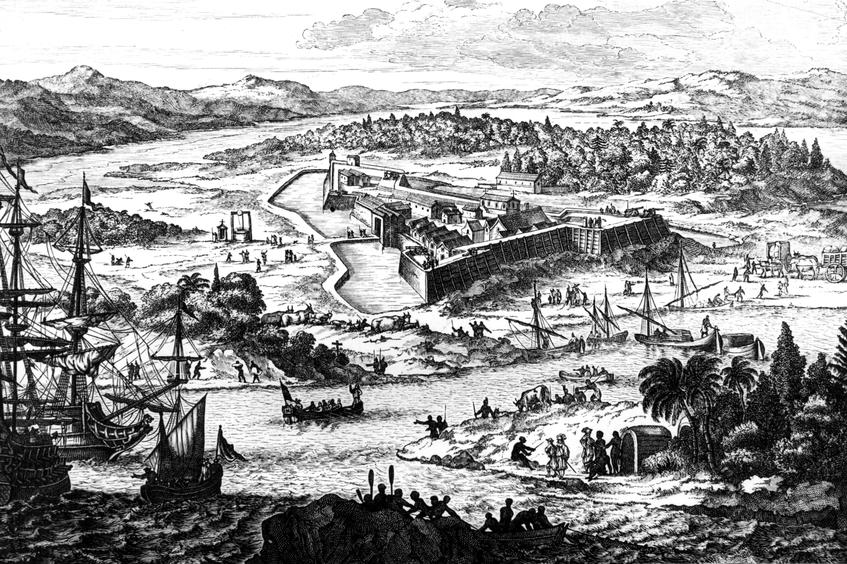
The Carolina territory was originally granted in 1663 by King Charles II as a reward to eight loyal nobles who helped restore the monarchy. This grant, called the Province of Carolina, covered a large area including what later became North Carolina, South Carolina, and even Georgia. However, the two areas developed separately from the outset.
North Carolina’s earliest settlers were Virginians moving south, establishing communities such as the Albermarle region near present-day Albemarle Sound. This area was far less suitable for plantation agriculture and had a farming economy focused on tobacco, lumber, and tar derived from the dense longleaf pine forests. Unlike the plantation economies of the south, North Carolina was a frontier region with rugged hills and heavy forests, particularly in the Piedmont, making large-scale farming and settlement difficult.
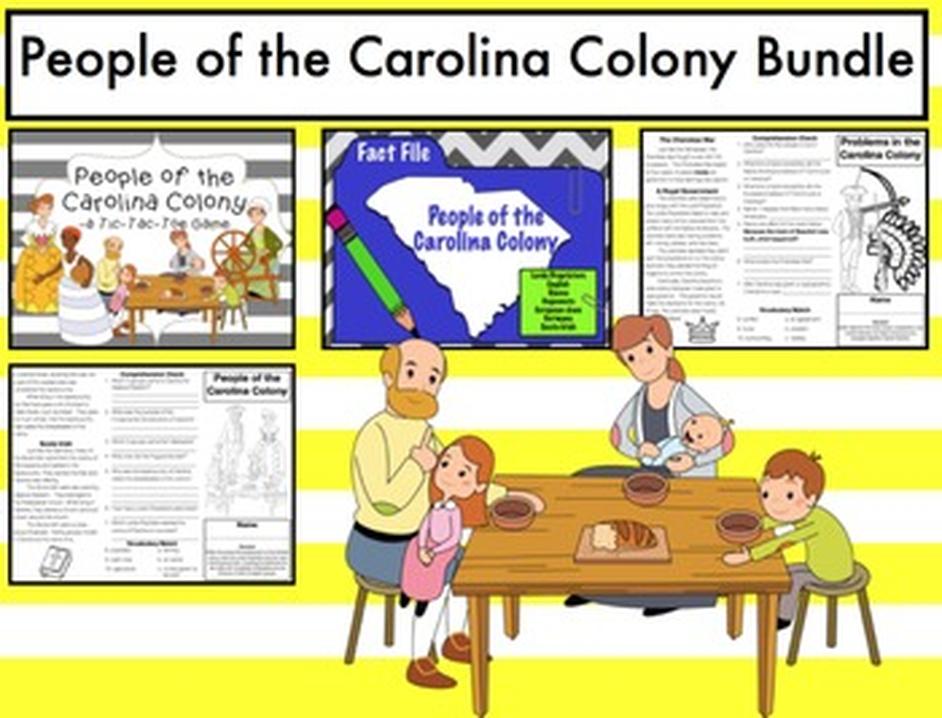
South Carolina’s founding came later with the establishment of Charleston and a distinctly plantation-based economy modeled after Virginia. Its geography favored large plantations with flat land and navigable rivers, facilitating more intensive agriculture and greater population density. This economic and geographic contrast shaped two diverse societies under a single colonial jurisdiction.
The administrative challenges of governing such different regions became apparent. The physical distance between population centers created logistical issues. The northern settlements, rugged and more rural, contrasted sharply with the southern, wealthier plantation towns. Furthermore, political decisions, including taxation and laws, often favored the interests of the southern plantation elite. This favoritism alienated northern settlers, many of whom moved farther inland to avoid the authority concentrated near the southern capital at Clarendon.
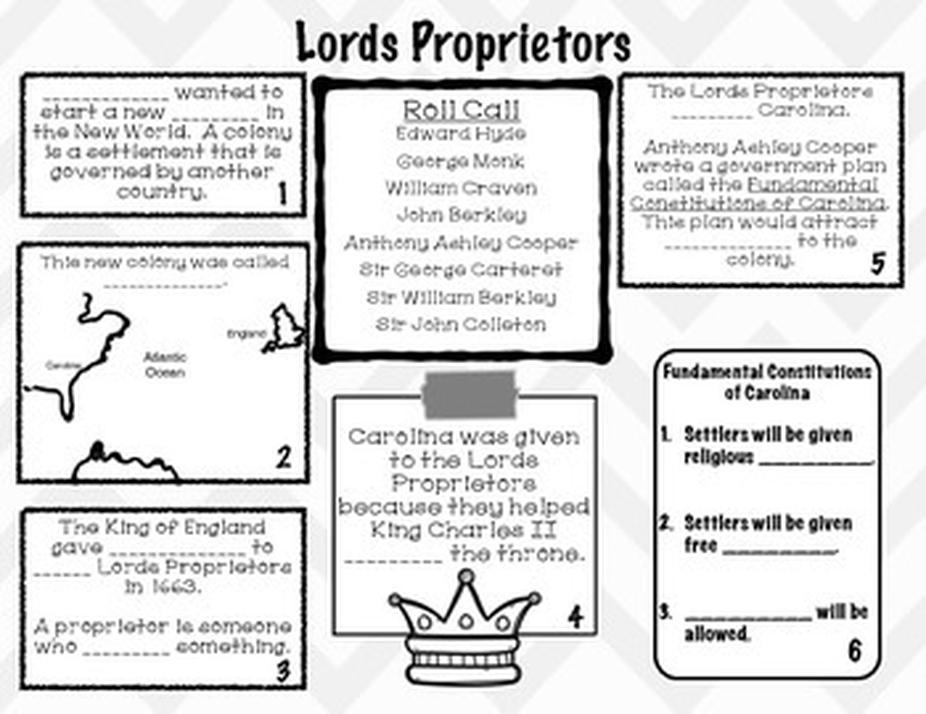
Over time, Clarendon lost importance and was eventually abandoned. By the early 1700s, South Carolina’s Charleston and North Carolina’s Albemarle emerged as the primary centers of their respective regions. These towns effectively acted as separate administrative hubs. The administrative separation became essential to address each area’s distinct needs.
Recognizing these realities, the Lords Proprietors officially acknowledged the division into North and South Carolina in 1712. Later, when the British Crown purchased the proprietary interests in 1729, it confirmed this separation, converting each into a royal colony with its own government. This formal split allowed each colony to pursue development aligned with local economic and social conditions.
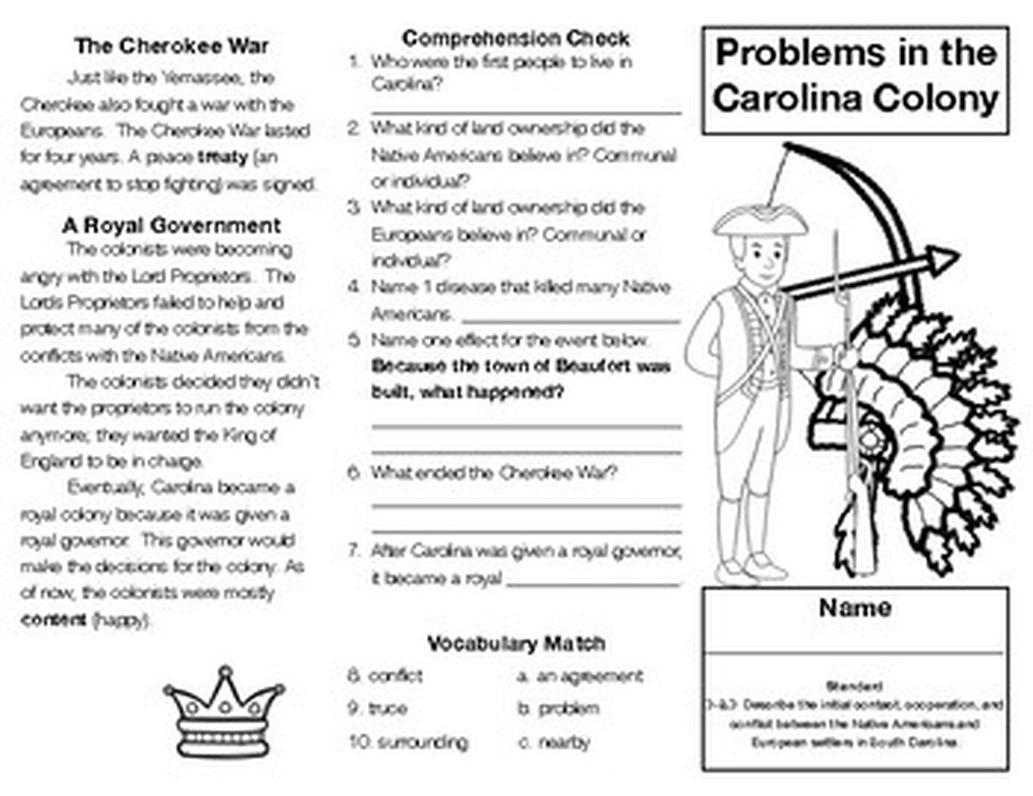
Notably, while the original Carolina charter included territory extending into present-day Georgia, there is little evidence that the Province of Carolina made serious efforts to colonize that area during this period. Georgia would later develop as a separate entity.
| Key Differences Leading to Carolina Split | North Carolina | South Carolina |
|---|---|---|
| Founding & Settlement | Settled earlier by Virginians, small farms, Albermarle region | Founded later at Charleston, plantation economy |
| Geography | Hilly, forested Piedmont, less hospitable land | Flat land, navigable rivers, ideal for plantations |
| Economy | Tobacco, lumber, tar from pine forests | Plantation crops, wealthy plantation owners |
| Political Issues | Felt taxed unfairly, distant from government | Governed from Clarendon, favored southern plantations |
| Administrative Centers | Albemarle settlement (later capital) | Charleston (major port & admin center) |
- The Carolina colony’s original large territory included what became North Carolina and South Carolina, with distinct settlement timing and patterns.
- Geographic and economic differences hindered unified governance and settlement.
- Southern plantations contrasted with northern frontier farms, creating social and political divides.
- Dissatisfaction over governance and taxation fueled separation desires.
- The official split occurred in 1712 by proprietors and was reconfirmed by royal authority in 1729.
Why Did the Carolina Colony Split into North and South Carolina?
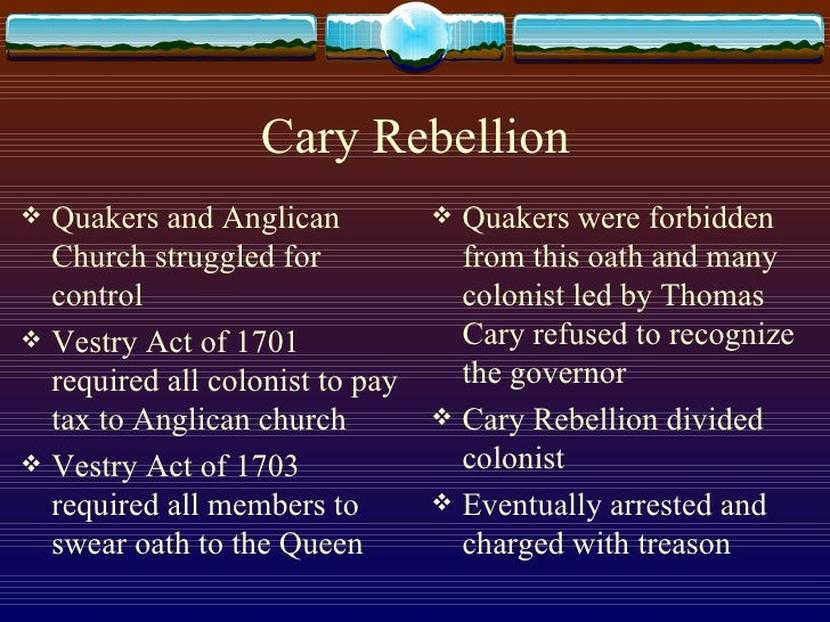
The Carolina colony split into North and South Carolina primarily due to distinct settlement patterns, geographic and economic differences, political challenges, and governance failures. This division evolved naturally over time before becoming official in the early 18th century.
Let’s unpack this tale of two Carolinas—because the story is both a geographic drama and a political saga.

Separate Origins: From the Start, Two Paths
The story kicks off in 1663 when King Charles II, grateful for loyalists’ help restoring the monarchy, granted a massive land chunk south of Virginia to eight nobles. They named it Carolina, after the King himself.
But things weren’t so uniform on the ground. In the north, the region called Albermarle was primarily settled by Virginians moving southward. These pioneers favored farming over plantations. Contrast that with South Carolina’s later foundation at Charleston, which blossomed into a plantation powerhouse like Virginia itself.
In fact, the North started with small farms and rugged settlers, while the South adopted plantation-style agriculture with crops like rice and indigo, which thrived on flat lands and fertile river valleys.
Geography Dictates Destiny
The land shaped the split almost as much as the politics did.
South Carolina enjoyed flat, navigable terrain and pleasant rivers, making it easy to settle and farm on a large scale. This terrain favored wealthy planters and dense settlement patterns.
North Carolina, on the other hand, faced tough challenges: hills, dense pine forests, and the wild Piedmont region where wilderness ruled. Settlers in the north confronted a more rugged, frontier-like environment with limited plantation potential. Instead, they built an economy on tobacco, lumber, and tar, tapping the abundant longleaf pines.
This contrasting geography created two very different colonial lifestyles—one of wealthy plantation owners and one of hardy frontier farmers—making unified governance tricky.
Political Struggles and Administrative Headaches
Running two such different colonies under one government wasn’t a picnic.
By the late 1600s, North and South Carolina were referred to separately, mostly because they had grown apart socially and economically.
The government, centered near Clarendon in the south, started passing taxes and laws favoring the rich southern cotton plantation elites—effectively ignoring northern interests. This made North Carolinians feel sidelined and discontent.
As a result, many northern settlers moved farther inland, seeking space and freedom from an administration that no longer served them well. This physical and political distance only deepened the divide.
The Formal Split: Recognition at Last
Things came to a head by the early 1700s. Heavy taxes and incompetent governors had weakened the Carolina colony. The central capital, Clarendon, was abandoned.
Only two major coastal centers remained: Charleston in the south and Albemarle in the north. These settlements naturally became the bases for two distinct colonies.
The Lords Proprietors officially recognized this division in 1712. Later, in 1729, King George II confirmed the split when the Carolinas were bought from the Proprietors and turned into royal colonies.
So the split wasn’t an instant decision but the outcome of years of growing differences.
A Quick Side Note: The Overlooked Georgia Connection
Interestingly, the original Carolina charter technically included lands that would later become Georgia.
Yet, historical records don’t suggest serious Carolina colonization efforts there at the time. Georgia’s later development came under different leadership and circumstances.
This tidbit highlights how colonial charters often outlined enormous territories that colonists didn’t immediately control or settle.
What Can We Learn from This?
- Geography matters: Easy terrain invites dense settlements and different economies than rugged frontiers.
- Different economies strain unity: Farming colonies and plantation colonies often held opposing interests.
- Political representation counts: Ignoring regional needs breeds discontent.
- Colonies evolve, especially over decades: The Carolina split shows that early America’s political borders often followed real social and economic divides more than arbitrary lines.
So, the next time someone asks why North and South Carolina exist as separate states, you can explain it was not just a political whim, but a natural consequence of geography, settlement, economy, and governance tangled together in a colonial drama.
Imagine settlers hacking through dense forests in the North, wary of taxes from far-away southern elites lounging on rice plantations. Or think of Charleston’s bustling docks, shipping wealth while northern farms creak under frontier hardship. This tale is about how people and place shape politics—and history.
How Does This History Impact Us Today?
The legacy of this split still influences North and South Carolina’s identities, economies, and cultures. South Carolina retains a plantation heritage; North Carolina embraces its varied geography and industry.
Understanding that both Carolinas grew from a single colony but split due to distinct forces can help us appreciate their rich, intertwined histories—and how geography and politics shape societies.
In short: the Carolina colony splits because it was never one colony in spirit. It was two, growing apart from day one.
Why were North and South Carolina settled differently?
North Carolina was settled mostly by Virginians moving south who farmed smaller plots. South Carolina, founded later at Charleston, grew into a plantation colony with large estates and enslaved labor, much like Virginia.
How did geography affect the split of Carolina?
South Carolina’s flat land and rivers made plantation farming easier and settlement denser. North Carolina’s hilly, forested Piedmont was harder to settle and supported tobacco, lumber, and tar industries instead.
What political issues led to Carolina’s division?
Governors favored wealthy southern plantation owners with taxes and laws. Northern settlers felt ignored and moved inland, creating separate political interests and tensions across the large colony.
When was the split between North and South Carolina officially recognized?
The Lords Proprietors recognized the split in 1712, and the King confirmed it in 1729 when the Carolinas became royal colonies, making the division formal and administrative.
What role did Clarendon play in the Carolina colony?
Clarendon was the original capital but was abandoned after failed governance and population shifts. Charleston and Albemarle became new centers, marking the start of separate North and South Carolina administrations.
